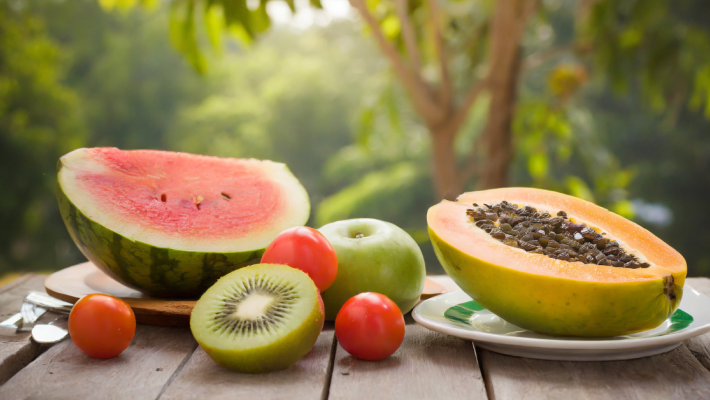Culinary Fruits
- €4,95
Productive and Disease Resistant Roma Tomato SeedsDiscover the exceptional qualities of Roma tomato seeds from the Rio Grande variety, known for producing a very high yield of firm, pear-shaped, deep red tomatoes. Each tomato can...
- €6,95
Compact Ruby Ann F1 Strawberry Seeds for Sweet FruitRuby Ann F1 strawberry seeds offer a unique opportunity to cultivate a compact strawberry variety known for its dark red strawberry flowers and high productivity. This hanging...
- €4,95
Exceptional Saint Pierre Tomato Seeds for Heirloom GardensDiscover the charm of Saint Pierre tomato seeds, an ancient French heirloom tomato prized for its robust growth and large tomato fruit. This Solanum lycopersicum variety is celebrated...
- €4,95
Classic San Marzano Tomato Seeds for SaucesDiscover the exceptional flavor and productivity of San Marzano tomato seeds, a cherished Italian Roma tomato variety prized for its intense taste and versatility. This Solanum Lycopersicum L. produces...
- €6,95
Early Harvest Snack Cucumber Kaikura F1 VarietyThe snack cucumber Kaikura F1 is a fast-growing snack cucumber prized for its early maturity and high yield. This hybrid cucumber seeds variety produces delicious, bite-sized fruits ideal for...
- €6,95
Early Harvest Snack Cucumber Kaikura F1 SeedsThe snack cucumber Kaikura F1 is a fast-growing cucumber variety prized for its early fruit harvest and high productivity. This hybrid cucumber seeds variety delivers a consistently high yield,...
- €6,95
Highly Productive Snack Tomato with Sweet FlavorThe Snack Tomato Dattolime F1 is a distinctive and productive tomato cultivar prized for its unique white-yellow fruit color and sweet, refreshing flavor. This variety, classified under Solanum lycopersicum,...
- €6,95
Sweet Snack Tomato Dattolime F1 CharacteristicsThe Snack tomato Dattolime F1 is a unique yellow snack tomato variety known for its exceptional sweetness and refreshing taste. This Solanum lycopersicum cultivar produces vibrant white-yellow fruits that stand...
- €4,95
Flavorful Spanish Cayenne Pepper Seeds for GardensDiscover the vibrant taste of Spanish Cayenne Pepper Seeds, a long slim variety of Capsicum annuum known for its sharp, spicy flavor. These cayenne chili pepper seeds produce fiery...
- €6,95
Premium Hybrid Strawberry Grandian F1 SeedsDiscover the exceptional qualities of Strawberry Grandian F1 seeds, a hybrid strawberry variety known for producing large fruit strawberries with impressive size and flavor. This everbearing strawberry variety thrives both...
- €6,95
Premium Strawberry Seeds for Large Fruit HarvestsExperience the joy of cultivating strawberry seeds from the remarkable Fragaria x ananassa Treasure F1 variety, known for producing exceptionally large fruit strawberries. These seeds yield sweet fragrant strawberries...
- €4,95
Unique Strawberry Spinach Seeds for Salad GreensDiscover the charm of strawberry spinach seeds, a distinctive garden spinach variety known as Chenopodium capitatum or strawberry goosefoot. This leafy vegetable seeds option offers edible leaves and fruits...
- €5,95
Vibrant Cherry Tomato Seeds for Sweet HarvestsDiscover the delight of growing cherry tomato seeds with the Super Sweet 100 F1 variety, known for producing abundant clusters of small, juicy fruits. These Solanum lycopersicum plants develop...
- €5,95
Delicious White Sweet Corn Cobs for SummerExperience the exceptional taste of Sweet Corn Glacial, a prized sugar corn variety known for its beautiful white color and extra sweet crunchy corn. This Zea mays cultivar produces...
- €5,95
Premium Hybrid Sweet Corn Seeds for Outdoor SowingDiscover the exceptional flavor of Sweet corn Tasty Sweet F1, an advanced Zea mays hybrid sweet corn variety known for its outstanding sugar content. This extra sweet corn...
- €4,95
Early Maturing Sweet Italian Bell Pepper SeedsDiscover the vibrant flavor and impressive productivity of the Sweet Italian Bell Pepper, a pointed sweet pepper variety cherished for its medium-sized horn-shaped fruits. This Capsicum annuum L. cultivar...
- €4,95
Vibrant Sweet Yellow Horn Pepper SeedsDiscover the unique appeal of sweet yellow horn pepper seeds, featuring the striking horn-shaped fruits of Capsicum annuum L.. This productive pepper variety is known for its deliciously sweet flavor...
- €4,95
Late Season Melon with Sweet Orange FleshThe Tendral Valenciano melon is a late honeydew melon variety prized for its oval fruit with a distinctive dark green, ribbed rind. Its flesh is soft, light orange, and...
- €4,95
Flavorful Tomatillo Seeds for Sweet and Sour FruitsDiscover tomatillo seeds from Physalis ixocarpa, known for producing juicy, sweet and sour fruits prized in many culinary traditions. Often referred to as Mexican husk tomato, these edible...
- €4,95
Vibrant Tomato Color Mix Seeds for Salad GarnishDiscover the Tomato Color Mix Seeds, a captivating selection of heirloom tomato seeds perfect for adding a splash of color to your garden and kitchen. This colorful tomato...



























































